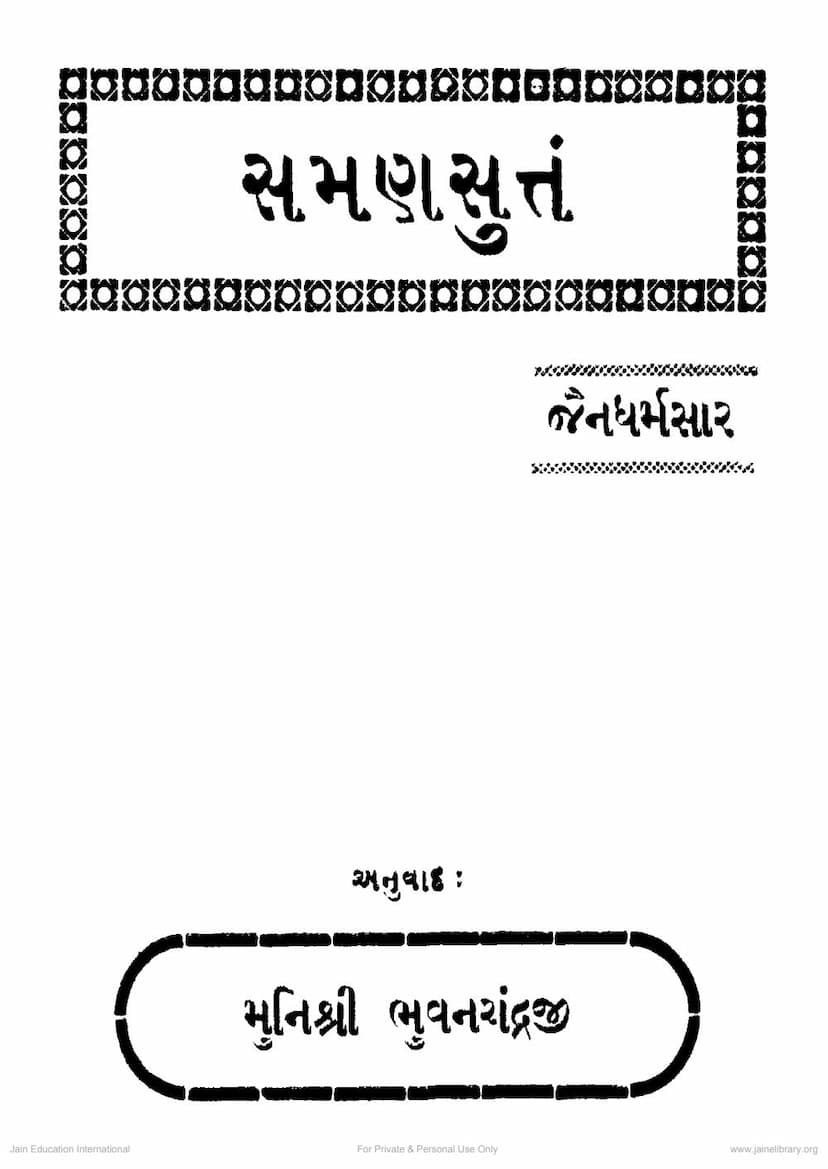Saman Suttam Jain Dharmasara
Added to library: September 2, 2025

Summary
The provided text is a Gujarati translation of "Saman Suttam Jain Dharmasara" by Munishri Bhuvanchandra. It is a comprehensive summary of Jain religious principles and philosophy, presented in a structured manner. Here's a breakdown of its key aspects:
Title: Saman Suttam Jain Dharmasara (સમણસુત્ત જૈનધર્મસાર) Author: Munishri Bhuvanchandra (મુનિશ્રી ભુવનચંદ્રજી) Publisher: Jain Sahitya Academy (જૈન સાહિત્ય અકાદમી), Gandhidham-Kutch.
Core Content:
The book is a Gujarati translation and simplification of the Saman Suttam, a foundational text in Jainism believed to be based on original scriptures known as the Agam Sutras. The translation aims to make the profound teachings of Jainism accessible to a wider audience, particularly Gujarati readers.
Structure and Themes:
The book is meticulously organized into four main sections, further divided into chapters, covering the entirety of Jain philosophy and practice:
-
Jyotirmukh (જ્યોતિર્મુખ - The Luminous Face): This section focuses on the initial stages of spiritual understanding. It guides the reader to detach from worldly pleasures, recognizing them as transient and ultimately sources of suffering. It emphasizes understanding the self, controlling desires, and embracing virtues like forgiveness, humility, and truthfulness.
-
Mokshamarg (મોક્ષમાર્ગ - The Path to Liberation): This is the most extensive section, detailing the Jain path to liberation (Moksha). It covers:
- Rattantrayi (રત્નત્રયી - The Three Jewels): Right Faith (Samydarshan), Right Knowledge (Samydan), and Right Conduct (Samycharit). These are presented as the core components of the liberation path.
- Practices and Virtues: Detailed explanations of various practices like vows (Anuvarat, Mahavrat), vows of restraint (Samiti), control of senses and passions (Gupti), austerities (Tapa), meditation (Dhyana), contemplation (Anuprksha), and the importance of the soul (Atma).
- Theological Concepts: Discussion of seven tattvas (realities) and nine padarthas (categories of existence), the nature of soul and matter, the concept of creation, and the self-reliant nature of the soul's journey.
- Syadvada and Anekanta: The philosophical principles of conditional predication (Syadvada) and manifold viewpoints (Anekanta) are highlighted as crucial for understanding truth and fostering tolerance.
- Ethical Principles: The paramount importance of Ahimsa (non-violence) as the root of Jain conduct, and its practice in daily life.
-
Tattva-darshan (તત્ત્વ-દર્શન - Philosophical Realities): This section delves into the metaphysical aspects of Jainism, explaining the fundamental principles such as:
- Dravya (દ્રવ્ય): The eternal substances of the universe (Jiva, Ajiva, Dharma, Adharma, Akasha, Kala, Pudgala).
- The Nature of the Soul: The soul's intrinsic qualities of infinite knowledge, perception, bliss, and energy, and how karma obscures these.
- Karma Theory: The detailed workings of karma, its types, and how actions lead to bondage and liberation.
- The Lok (લોક): The structure and nature of the universe.
-
Syadvada (સ્યાદ્વાદ - The Doctrine of Manifold Viewpoints): This section focuses on the epistemological and logical principles of Jainism, explaining:
- Naya (નય): Different valid perspectives or standpoints for understanding reality.
- Pramana (પ્રમાણ): Valid means of knowledge (Perception and Inference).
- Saptabhangi (સપ્તભંગી): The sevenfold predication used to describe reality from multiple viewpoints.
Key Themes Highlighted:
- Ahimsa (Non-violence): Presented as the supreme principle of Jainism, encompassing thought, word, and deed.
- Self-Reliance: The emphasis on the soul being its own master, creator, and destroyer of its destiny.
- Detachment: The necessity of renouncing attachment to worldly possessions, relationships, and even the physical body.
- Austerity and Discipline: The vital role of tapas (austerities) and samyama (restraint) in purifying the soul.
- Spiritual Evolution: The concept of soul's journey through various stages of development (Gunasthanas) towards liberation.
- Universal Truth: The Jain belief that truth is one, but it can be viewed from multiple perspectives (Anekanta).
Context of Translation:
The preface and introductory notes reveal that the publication of this Gujarati translation was a significant undertaking, involving the permission of the "Yajna Prakashan Samiti," contributions from various scholars and Munis, and the dedication of individuals like Shri Mavjibhai Savala. It also mentions the inspiration drawn from Acharya Vinoba Bhave's work on synthesizing the essence of various religions. The translation aims to present a clear, accessible, and inspirational guide to Jain teachings for both Jain and non-Jain readers.
In essence, Saman Suttam Jain Dharmasara by Munishri Bhuvanchandra is a valuable resource that systematically explains the core tenets of Jainism, its philosophical depth, and its practical path to spiritual freedom.